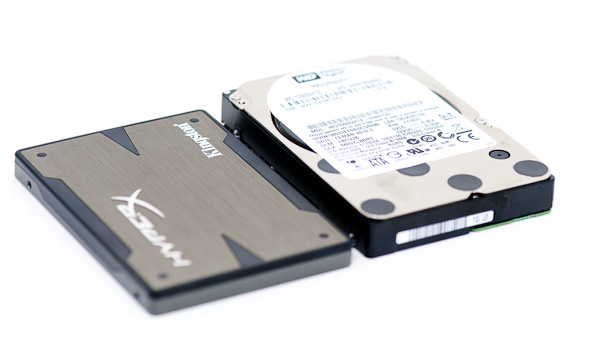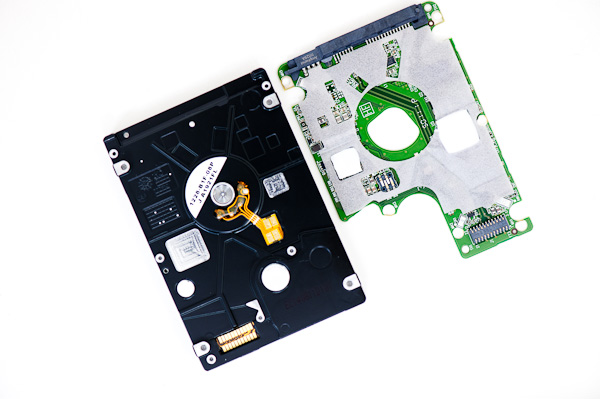Western Digital VelociRaptor 1TB (WD1000DHTZ) Review
by Anand Lal Shimpi on April 16, 2012 8:00 AM EST- Posted in
- Storage
- HDDs
- Western Digital
- VelociRaptor
Final Words
The new VelociRaptor does reclaim its title as world's fastest client hard drive, and I do appreciate the fact that WD hasn't raised prices on the drive in the past two years either. Compared to any 3.5" drive on the market today, the new VR is significantly faster without a doubt. Random IO performance is at least double most 3.5" drives, and sequential performance is almost 50% better than the fastest competitors. Most impressive is the fact that power consumption is actually competitive with modern 3.5" green drives as well, another benefit of the VR's 2.5" package.
The biggest problem for the new VR today is the same issue we had two years ago: SSDs are much faster, and are quickly becoming more affordable. As a primary drive I wouldn't recommend the VelociRaptor simply because you can get a better overall experience with an SSD. We have a number of very reliable, reasonably affordable (128GB), high-performing SSD options to choose from. Intel's lineup, Samsung's SSD 830 and Crucial's m4 all come to mind.
As secondary storage, the new VelociRaptor appeals to those users who need more capacity than an SSD can affordably offer, for active use. Launching applications, games, and working on (not just streaming for playback) large data files are all going to be quicker on the VR than on a standard 3.5" drive. If you're building the ultimate workstation, you could use an SSD + VR for internal storage coupled with some larger, slower drives in RAID as a backup or for your more passive data (movies, music, edited photos). For most users however, I'd honestly recommend an SSD plus a couple of large, 5400/7200RPM drives in RAID-1 for everything you can't store on your SSD. While the Raptor line was quickly embraced by the enthusiast, I believe it has transitioned exclusively to a workstation role.
I have to admit I was disappointed to see that Western Digital went conservative on the new VelociRaptor design and didn't include any on-board NAND to really mix things up. What I was hoping for was a combination of the VelociRaptor and Seagate's Momentus XT. Perhaps that doesn't make sense given the available SSD caching solutions available today, but I don't see the harm in pairing even a small amount of NAND with the drive. I don't see hard drives going away anytime soon, so we might as well try to make accessing them as quick as possible.
Then there's the extreme option. I would love to see a manufacturer treat a hard drive as an SSD with a mechanical counterpart, rather than a hard drive with some NAND on it. I'm curious to see what a VelociRaptor (or any other 2.5" HDD) with 64GB of NAND used as a read/write cache would behave like. If users are able to fit all of their program, apps and data into a 128GB SSD, I have to believe that a well managed cache can deliver compelling performance with half that space.
Unfortunately most hard drive companies seem slow to adopt NAND into their designs, so I suspect much of this will have to be a dream for now. The new VelociRaptor is a great evolution of the design and it's truly a very fast hard drive. Just as before, if I needed to buy a high-performance mechanical hard drive, it's the one I'd pick.












92 Comments
View All Comments
gammaray - Wednesday, April 18, 2012 - link
Those drives dont make any senses at all at their pricing range. None whatsoever. at 300ish$ you can get an awesome SSD, fast and quite large relatively speaking.If you really need lots of GBs then one has to go with the 2-3Tbs for half the price.
Even with a 25% cut i would never consider the new velociraptor offering.
What are they thinking?
gammaray - Wednesday, April 18, 2012 - link
Also,while it doesnt affect performance, SSDs are SILENT
and silence is worth a lot.
JonnyDough - Thursday, April 19, 2012 - link
"There's just one problem: Moore's Law is driving the cost of SSDs down, and their capacities up. The shift to solid state storage is inevitable for most, but to remain relevant in the interim the VelociRaptor needed an update."Moore's Law is doing it? Really? All by itself? I'm sure it has nothing to do with economies of scale....
Maybe someone should take some college courses and not try to sound so smart.
DukeN - Thursday, April 19, 2012 - link
Maybe a 16GB $50 caching SSD, perhaps?superccs - Thursday, April 19, 2012 - link
a 1Tb WD Black or Samsung/Seagate F3 is $130 and they are fast.a 1Tb Raptor is ~$280 if you can find one....
Is it 2x as fast or did WD just release a product with an impossibly small niche?
We all know that the smaller SSD + 1Tb fast platter works well for system drives. Would anyone recommend this drive for that 1Tb duty over any of the competitors?
UberApfel - Thursday, April 19, 2012 - link
Nobody knowledgeable buys a VelociRaptor for I/O performance nowadays. They buy them for peace-of-mind; reliability.How about some estimated reliability graphs? At least of the previous model?
maz35 - Saturday, April 21, 2012 - link
would a ssd and VelociRaptor be good for a gaming rig?Tchamber - Saturday, April 21, 2012 - link
Wouldn't be bad at all. I have two of the original 300gb Velociraptors in RAID0, and they're fast enough that I don't feel the need to upgrade to an SSD.Jeff9329 - Tuesday, May 1, 2012 - link
I understand that SSDs are far faster, but it's seems to me they are still currently well over 3X as expensive. I was just looking at a 600GB Intel SSD but it was over $1,000USD.I would like to update one of my video editing machines from a 300GB Velociraptor boot drive (almost full) to a 600GB SSD boot drive, but the cost is awfully high.
Im also not sure I can use my existing image on the SSD. Re-building the editing suite configuration on a new drive would take days. Can you move an SSD image to another SSD or do you get caught up in re-building the drive image with each new SSD drive?
As for the 1 TB Velociraptor, it's a little large for a boot drive, but too small for a video editing data drive. However, the price is right, so using it for a boot drive is an idea.
astrojny - Friday, May 4, 2012 - link
Wouldn't that make a lot of sense. For around $400 you should get a very speedy setup no?